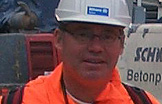Beat Guggisberg: The first thing that came into my mind was: we've done it! When the boring machine cut through the final section of rock, a vision became reality. But at the same time it occurred to me that we are actually only halfway along our journey from when the project started with the construction of the Lötschberg Tunnel in 1999 to its final completion in 2019. By then, many of those involved in the build will have spent a large part of their working lives on the project.
The faster track
Mr. Guggisberg, you have provided insurance support for the NEAT construction site for over ten years now. How did you feel when the Gotthard Base Tunnel breakthrough actually happened?

How did you celebrate the breakthrough?
Guggisberg: When the Lötschberg Tunnel breakthrough took place in 2004, there were still around 2000 people down in the shaft – as an insurance expert that did make me rather nervous. The celebrations in Sedrun, by contrast, were mainly for the miners, politicians, media and local residents. I myself was able to witness the breakthrough at the Lucerne Culture and Congress Center together with many others. It was an extremely successful event, complete with a display by the Patrouille Suisse aerobatic stunt team. I also felt a definite sense of relief amongst all those involved in the project who were at the celebrations.
What major losses have there been since tunnel construction began?
Guggisberg: The most dramatic incident was definitely a conveyor belt fire at Sedrun which could be seen from several kilometers away. And the image of a mobile crane lying prostrate on its back like a beetle because it had insufficient counterweight also sticks in my mind. The loss incident which received most media attention was a microquake in Faido which damaged the tunnel. Overall, however, the lead construction company is extremely safety and quality conscious, which we as insurers are of course very pleased about.
Now comes the fit-out of the tunnel. What risks is Allianz Suisse still exposed to?
Guggisberg: Basically, the risk of fire in the tunnel remains high, as a lot of electric cables are being laid. In the Lötschberg Tunnel, for example, an emergency power supply battery container exploded, causing a great deal of damage. At the end of the fit-out phase in particular the potential risk rises significantly, because during test runs there is a risk of damage to the tracks as well as to personnel.
What will you do in 2017, when construction of the Gotthard Base Tunnel is scheduled to finish?
Guggisberg: I will be working on the construction of the Ceneri Tunnel until 2019. Then I'll tidy out my office and hand over my claims folders, because in 2020 I begin my hard-earned retirement. I do however have mixed feelings about that, because I have been involved in the NEAT Project since 1990 as an engineer in the project phase, so it really is my life's work.
As with all content published on this site, these statements are subject to our Forward Looking Statement disclaimer.
Link to the disclaimer